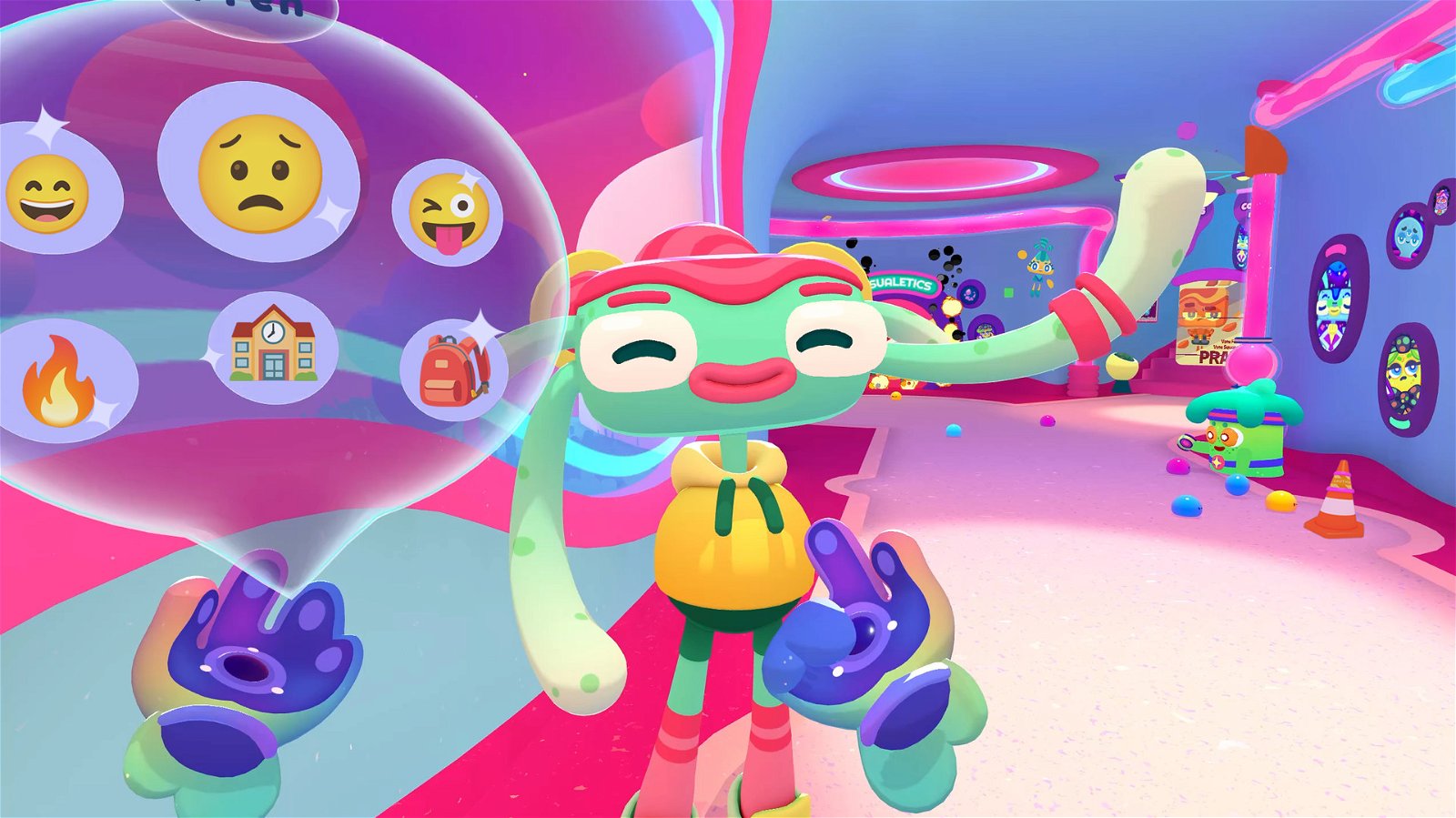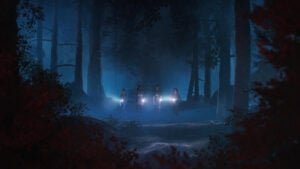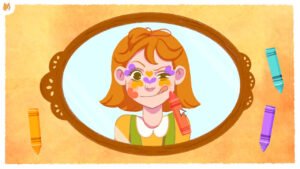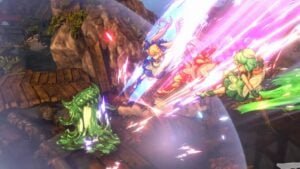Three VR games in, Carrie Witt still finds her best joy from convincing players what they see is real. All while reminding them it’s okay to let loose and have fun. The Art Director at Owlchemy Labs found this special satisfaction as early as 2016. When true consumer-level VR headsets like the HTC Vive first brought immersive games forward. Waiting for early owners was Job Simulator, which was Owlchemy’s first foray into VR games. From turning less glamorous jobs into fun levels. To letting players commit professional sacrilege at fictional workplaces. Job Simulator and Vacation Simulator both provided a gateway for players testing the VR waters in digestible experiences. For a brief moment, Witt finds the effect “especially positive,” by creating a believable world that’s also fun.
Through the studio’s next IP, Cosmonius High puts players back into a classroom. According to Witt, it still retains Owlchemy’s distinctive visuals which take players away. But with more than enough science fiction flair inspired by retro futurism. Then adding a fun spin on daily tasks for added measure. In this process, Cosmonius High turns players into an alien. Blasting off towards a new semester in the game’s titular school. A few surprises come from the various classes players take. Both serving as Cosmonius High‘s levels and sending the right amount of flashbacks for older players.
CGMagazine took an opportunity to sit with Owlchemy Labs for an early glimpse into Cosmonius High. Through Art Director Carrie Witt, we learned more about how design choices translate into gameplay. Along with the team’s current challenges in development and species players can expect in VR.
CGMagazine: Cosmonius High is a clearly different game from the Job Simulator and Vacation Simulator series of games. What was the biggest change you had to make in your work process on Cosmonius High?
Carrie Witt: Oh, man, that’s such a big question. So much of what we’re doing with Cosmonius High is building on the successes and learnings from Job Simulator, Vacation Simulator, and Rick and Morty. Since this is a new IP, we’re using that as an opportunity to try and improve on all of those things. As far as art direction goes, Cosmonius High took a completely different approach to what we had done previously.

A big factor in what we did for Jobs and Vacation Sim was dictated by what resources we had available to us on the art side that kept things simple enough to fit the workload but still be cool and unique in its own way. Cosmonious High was an opportunity to be like, ‘okay, cool, we focused so much on subverting the familiar in Job Sim and Vacation Sim so now let’s start from something alien and work from the ground up and use it as a place to explore all new different aesthetics, powers and interaction mechanics.’
CGMagazine: When you were laying out the vision for the game as the art director, what were some of the art styles the team imagined before settling for the one we’ve seen in the trailer so far?
Carrie Witt: Initially we wanted to do aliens, but we don’t want to do anything scary, or deep, dark, or anything that would come across horror. But we could use it as an opportunity to make space feel welcoming, and a more positive concept. So we looked at a bunch of old sci-fi art from the 60s and 70s, where there are a lot of utopic themes within the art direction. A lot of rounded shapes, and interesting forms.

So that was a big touch point in the beginning. Then taking influence from various illustrators I like and seeing how they depict space and be like, ‘okay, cool. Look at all the different ways that space has been represented visually in more traditional art.’ How can we pull some of that into this game space where, I’d rather not have a scary black overwhelming look to the experience. Let’s use bright pinks and purples and get really colourful to make this unique and our own concept.
CGMagazine: Speaking of space, what were some of the challenges you faced from taking those concepts? And laying it out in this large 1:1 scale VR world for players?
Carrie Witt: I feel like that was one of the biggest challenges in Cosmonius High, coming from Vacation Sim and Job Sim. As it’s hopefully evident from the trailers that we’ve released, you’re in a school space station where you’re able to freely teleport around. Job Simulator was ‘okay, here’s your station, essentially in all these different locations.’ And that’s where you’re contained. In Vacation Simulator, you have contained stations, but within a bigger environment, so you can walk around in a sense.
With Cosmonius High, we’re essentially creating a full architectural space that you can explore, which is very challenging. Clearly, the scale is much bigger than what we have done previously. But I think that one of the things with a new IP that we can improve on. We wanted to add to the immersion of the player by allowing that free teleportation that truly allows the player to have a sense of exploration.
CGMagazine: So now that you’re free from building on the Simulator series, were you finally able to do things that you couldn’t from those games – now that you’re working on new IP?
Carrie Witt: Totally. So, having more resources, in terms of dev power, was a big one. That was one of the reasons we pushed the visuals as much as we did. At a high level, we were looking at 2D animated cartoons as a point of reference. You get more texture in the background, and the characters are cleaner — almost cel-shaded — to help with the visual hierarchy. Especially now that you have such a big space to explore.

There’s so many avenues to explore here. I think a big one would have to do with the characters, which are such a big centrepiece of Cosmonius High. Basically, the TLDR of the direction for the bots in the previous games, was how we didn’t really have the resources to do any actual character animations. So, having screens that could have sprites to swap out for different emotions and expressions was much simpler to do, and something that we could do with the resources we had at the time.
The fact that they’re all essentially floating heads with no limbs made that all very easy. But something we’ve noticed in how players interacted with those faces, is that there was a lot of desire to interact with the characters more deeply. Especially in Vacation Simulator, as the characters in the world had more personality to them and more going with implied backstories. We saw this as an opportunity to make characters that you could interact with much more directly. They actually feel like people and entities in the world with you, rather than characters in a simulation.

The other huge difference between this and the Simulator games that we wanted to improve on was the depth of interaction with the player and the things in their world. So much of the immediate joy and delight of the Simulator universe is being like, ‘Oh, here’s the space that’s familiar. Here’s some stuff, I’m going to hit these things and throw them across the room because I could never do that at my job at the convenience store. But now I can.’
So the powers we have the player unlock throughout the game are us exploring the depth of those different interactions. As we showed in the teaser trailer, there’s an ice power, there’s a water power, which all effect the environment, objects and characters in different ways. There’s so much more depth and interaction to what they can do. And beyond the powers we’ve shown so far, we played with the space and what would be fun to do as a player in ways we’ve never been able to do before in our previous games. Just given our resources and the overall thematic nature of past titles.
CGMagazine: Now with more resources, the game’s visuals and having to make that work for VR gameplay, what are some of the conversations you’ve been having with the developers about your art style?
Carrie Witt: So obviously, optimization is always a huge challenge for VR. That’s something we’re doing currently, especially as our models have a much higher polycount than in previous games. There’s a balancing act between the visuals and the technical limitations of what we need to do to hit a framerate, so everything runs smoothly on all the VR devices.
Starting with that and adding familiar elements on top of it, we can then ask how we can use design to give the player enough insight into their affordances. What we can do to make the game universe feel approachable and something that players can investigate and understand, rather than have that be a frustrating experience, where it’s like, essentially bad industrial design. This leads to situations where the player does not know how to use a thing, or it looks like it should do this, but it can’t do that. Accounting for affordances has been a huge part of the development of this game.
CGMagazine: And as you mentioned, I thought it was interesting thing when you said that there are things done to help players in VR. See different things apart, like different parts of the map or even things they could interact with. Now visually, what are some of the things that you do to set some objects apart more than others?
Carrie Witt: So, at a high level, a part of this was the overall art direction. Adding more texture to the background elements, versus things that you can interact with. The very first aspect of design is based about the visual hierarchy clue that, ‘okay, this is something I can interact with.’
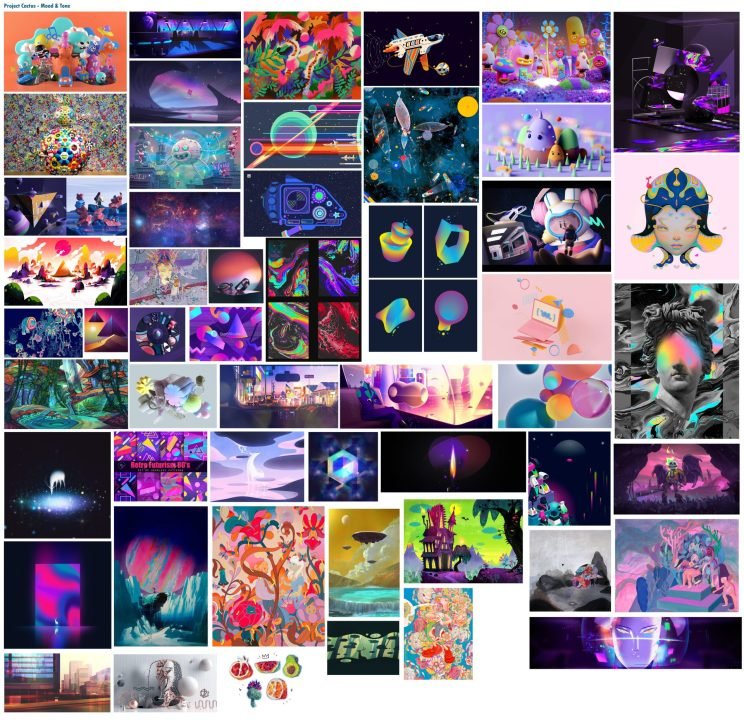
But another part of that is a lot of industrial design properties that you would see applied to real world objects. Obviously, we’re not focusing on the materiality or how something needs to be constructed in the physical world to work. But, we do need to look at visual signals from the real world that we can bring in and use here to convey how to interact with something.
So one of the interactions that we use a lot in Vacation Simulator and brought over here, is the height adjustment for the tables, which is big for ergonomics and accessibility. Where essentially, there’s a bunch of cool stuff you can do here. But if you’re too short, too tall or whatever the reason, you’re able to adjust the height of it for whatever is most comfortable for you. Outside that, trying to use colours and more detailed illustrations or textures to highlight the most important parts to look at and focus on. The same with interactive parts, like levers or buttons, stuff like that. Making those elements look really juicy, drawing the players’ attention to it.
CGMagazine: And in terms of that feedback, what were some of the more important colours that you had to use when helping players see things for visual feedback?
Carrie Witt: So because of the previous work we’ve done with colourblindness, we use a lot of hot pink rather than a red and yellowish green, for the good ‘yes’, and leaning into some oranges, and yellows for cautionary stuff. We found through experiences with past games that leaning into the colour library, that we have already understood thanks to our experiences interacting with the world, helps when it comes to accessibility.

Outside that, colour contrast is a big one, where we use a lot of pink in general in the game. So just having the bright red doesn’t necessarily afford danger, per se. But making sure that important elements have enough visual contrast with the surrounding colours. Especially with how colourful the whole game is, that contrast helps draw visual attention where it needs to. There’s a lot of factors at play to help the player focus their attention and differentiate a good thing, or a bad thing in the game world.
CGMagazine: Now, a lot of us are going to be dropping into a familiar space. 10 minutes into the game. Obviously, we’re all going back to high school. Some people are going for the first time more than others. But could you tell me more about how you managed to strike a balance between that familiar high school setting with this intergalactic universe you’re looking to put out?
Carrie Witt: Yes, so we know that high school is a very loaded topic for so many people. For a lot of folks, that can bring up not-so-great experiences or troubles coming to terms with who they are versus what their classmates, or their parents want them to be. We really wanted to use that as an opportunity to offer a more hopeful vision of the future. An alternative to high school, and say ‘man, wouldn’t it be cool if that’s what high school was like for us?’ So part of that was leaning into stereotypes of high school in terms of cliques and interests.
We refined these further and further through development. We wanted to avoid leaning into those stereotypes in a way that’s negative. Rather be like, ‘okay, cool, we have this character that visually recognizable as a jock, his name is Honk. And he’s super into the sport in our game called Planet ball.’ We’re taking that stereotype of the visually familiar. This person’s into sports and knowing he’s just super stoked about this game, and he’s excited to play it with other people. He’s a good dude. Using that familiarity but presenting it in a way that is hopefully new and refreshing.

Instead of being ‘oh, no, I have to relive my horrible high school experience, I don’t want to do that.’ We want to have various elements of classrooms that would be familiar, even though they’re presented in a wholly different way. For example, the chem-osophy classroom, you have a desk set up with all of your chemistry type equipment. But have the classroom itself be a more open and welcoming place. It’s not a place where everyone sitting behind their own individual desk. Instead, we ask the question of ‘wouldn’t chemistry be cool if you could work with your lab partner and have more free rein in the space?’ Because just recreating school — one for one — would not be fun.
CGMagazine: By going into that space and meeting all these different characters, I can imagine that some characters were more fun to design than others. Any chance you could tell me more about a few of the ones you worked on?
Carrie Witt: There are 12 students in total, I believe. And we have three different species that all of these characters could be. We have the ‘Bipids’ who are the more humanoid looking aliens as a familiar touch point. They have arms on their head, and they stand on two feet. We have the ‘Flans’ which are more slime, gooey-like characters, and we have the ‘Trisk’ who are multi-dimensional beings who go in and out of timespace. Basically at will, because that’s fun for them.

At ground level, tackling these three different alien species was a really fun experience. Then figuring out which of our characters would work best in the different species was a whole thing in itself. But I really like the Flan characters, just because they’re essentially just a beautiful gradient with some accessories, with so much of their attitude and personality written on their face. My personal favourite being ‘Gleg’—the resident goth or ‘Guth’ in-game—who has spiky headset listening to his drum corps music. He was fun to create, and was someone that make me think, ‘man, that’s that’s who I would like to be or be friends with if I could go back and do high school again.’
CGMagazine: So obviously, there are a lot of different things to balance in keeping Cosmonius High look the way it is. Now, what were some of the criterias that you had when you were looking at something and thinking it might be too real, or it’s just fictional enough for players?
Carrie Witt: That was a driving factor behind the aesthetics of basically everything in this game. Which I think keeps everything, whether it’s the characters, or the props from Pete, from feeling too realistic. It’s leaning into obviously a very cartoony aesthetics. One with a very colourful use of gradients, both on characters and the world. Everything is very much rounded and chamfered and tapered. So we had basically, in a lot of our back and forth discussions, landed on, ‘does it look like I want to eat it,’ and this points to a quality for approachability for everything.

The idea of Juicy and adorableness was something we used to describe characters and props along with everything in the game when we asked: ‘is this right?’ Because if it feels like I just want to hug it or wish I could eat it we hit the mark. That willingness to engage with it, is the check mark of the visuals for this thing. It’s great. One example of that being the ‘Blebs,’ those little round, jumpy aliens that you see in the hall. Everyone’s reaction to those are very much, ‘oh my gosh, I want to eat them, but also love them and protect them.’ We’re just using that as a marker of what feels right. And showing that it’s consistent with this overall world that we’ve created.
CGMagazine: And so, how were you able to create one art style that works for multiple VR platforms without changing up the quality too much?
Carrie Witt: I think overall, the Owlchemy high level brand’s art style is very much cartoony and colourful. That’s obviously manifesting differently for Cosmonius High than it did for Job Sim, Vacation Sim or Rick and Morty. But leaning into a visual style that doesn’t need to be realistic, allows for a lot of different techniques that essentially saves on performance or memory. It makes optimizing it a bit easier on that front, and I genuinely cannot imagine the trials and obstacles, you’d have to undergo creating a realistic VR experience and getting it to run on the Oculus Quest. Which is essentially a phone computer. So I feel choosing a style that is visually inherently more simple or clean, allows for a lot of room to make it easier to work well across all of these platforms.
CGMagazine: In starting a whole new game. Working on Cosmonius High, did you feel like you had a lot more freedom to play around with these requirements to make your game work for these different systems?
Carrie Witt: I would say especially early on and doing Cosmonius High. Because this is a new IP and we really want to push the bounds of what we’ve been able to do visually. Let’s just create stuff from the ground up we think is cool, and not be worried about the optimization part until later. Which is what we’re focusing on now. Making sure that what we do looks great, and runs well for PC VR. It’s definitely tricky to accommodate all the visual decisions and intricacies that we’ve done. To say it’s a challenge, which is essentially an understatement.

But at a high level, knowing that the style choice lends itself to these optimizations is a good thing. It’s not like there’s going to be a huge shift in visual quality as we adjust for performance. The way we choose to visually design our games from Job Sim through what we’re doing with Cosmonius High lends itself better to that. Compared to something more realistic, where you can see all the details, just can’t make that transition and look as consistent when working with more challenging platforms.
CGMagazine: And to take a step back as well. Was that something you had to think about when you brought Job Simulator from those older systems into something completely new like the Oculus Quest?
Carrie Witt: I know that there’s definitely challenges bringing Job Sim to different platforms. And I don’t want to misspeak. But I feel that a lot of those challenges had more to do with getting the aspecs we programmed in Unity to work correctly across all platforms. Porting is always a challenging process for sure.
And last time around on Vacation Simulator, we did have a contractor help us with the porting. Especially because PlayStation VR is a challenging platform to get stuff to run on. Because it’s an older console at this point. I still love my PlayStation 4. I use it every day. But it is still old hardware. So I feel like there’s definitely more challenges on the gameplay and optimization side on that front than there were visually. But there are definitely a lot of issues to address.

Originally, there was a lot of reworking of the cubical spaces that the player had to interact with their environment. We had to make multiple versions of those, essentially for different platforms, based on optimization that was available. A big challenge before was making sure that stuff could fit properly within a 180-degree cone of vision, especially on PlayStation VR. And that was a huge challenge on Job Simulator and Vacation Simulator. It’s essentially taking the environments and gameplay that we had put together and making sure that we could get that same level of quality in these essentially modified versions for different platforms.
CGMagazine: Carrie, before I let you go, I do have to ask: from building that vision of Cosmonius High. From the concepts, to what it is going to be in VR. Then bringing that to life. What are you hoping that the players get to appreciate from your side of things when they finally get to go into Cosmonius High?
Carrie Witt: Oh, man, that’s such a good question. I feel like, at a high level, one of the biggest joys for me, as someone who creates stuff for VR, is seeing the magic of a player existing in a space that they know isn’t real, but their brain believes it’s real. Getting to live in a cartoon world with characters that can’t exist in real life, and having that feel authentic is always so incredibly magical to see for me. And I’m really excited to see how players like and engage with the characters, because that’s one of the huge focuses of this game. I’m really hoping that players get the same joy of engaging with these characters as I do. It really feels like you’re interacting with other people, and they have their favourite artists, they have their favourite musician, have their own backgrounds and personalities. To have that feel real and good, I think is super cool.
I feel like that can be especially positive for players, especially after the past two years of COVID, where a lot of folks have been distanced from each other for so long. A lot of kids who are in school have not been at school. I’m really hoping that can be a positive source of engagement. It’s never going to replace the real thing of course, but I think getting to empathize with another character and feel like they’re existing in a space with you, can be super powerful.
